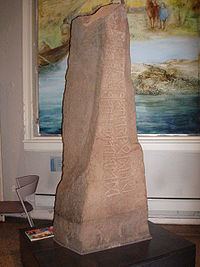Rundata ID N KJ72 U Runemaster Wiwaz | Produced 200–450 CE Region Østfold | |
 | ||
Tune stone two callers in one
The Tune stone is an important runestone from about 200–450 CE. It bears runes of the Elder Futhark, and the language is Proto-Norse. It was discovered in 1627 in the church yard wall of the church in Tune, Østfold, Norway. Today it is housed in the Norwegian Museum of Cultural History in Oslo. The Tune stone is possibly the oldest Norwegian attestation of burial rites and inheritance.
Contents
Inscription
The stone has inscriptions on two sides, called side A and side B. Side A consists of an inscription of two lines (A1 and A2), and side B consists of an inscription of three lines (B1, B2 and B3), each line done in boustrophedon style.
The A side reads:
The B side reads:
The transcription of the runic text is:
The English translation is:
The name Wiwaz means "darter" while Woduridaz means "fury-rider." The phrase witandahlaiban that is translated as "my lord" means "ward-bread" or "guardian of the bread." (The English word "lord" similarly originated from Old English hlāford < hlāf-weard literally "loaf-ward", i.e. "guardian of the bread".)
Interpretations
The runic inscription was first interpreted by Sophus Bugge in 1903 and Carl Marstrander in 1930, but the full text was not interpreted convincingly until 1981 by Ottar Grønvik in his book Runene på Tunesteinen.
